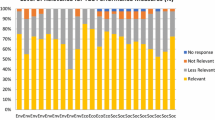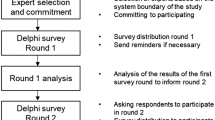Abstract
The sustainability assessment of the biogas production from palm oil mill effluent is complex, so it requires indicators that represent the sustainability concept of the system. This study aims to determine sustainability indicators of the biogas production system from palm oil mill effluent using the participatory analytic hierarchy process. This study results in ten sustainability indicators, in order of importance, consisting of the availability of raw material, profitability, greenhouse gases emissions, energy efficiency, water usage, production cost, investment, installed capacity, residents benefits, and job creation. These indicators help evaluate the sustainability of the biogas production system from palm oil mill effluent in the Bangka Belitung Islands and other regions in Indonesia.
Access this chapter
Tax calculation will be finalised at checkout
Purchases are for personal use only
Similar content being viewed by others
References
BPS (2020) Statistik Daerah Provinsi Kepulauan Bangka Belitung, Tahun 2020. BPS Provinsi Kepulauan Bangka Belitung, Pangkalpinang
World Commission on Environment and Development (1987) Our common future. Oxford
Sala S, Ciuffo B, Nijkamp P (2015) A systemic framework for sustainability assessment. Ecol Econ 119:314–325
Afgan NH, Carvalho MG, Hovanov NV (2000) Energy system assessment with sustainability indicators. Energy Policy 28(9):603–612
Liu G (2014) Development of a general sustainability indicator for renewable energy systems: a review. Renew Sustain Energy Rev 31:611–621
Hák T, Moldan B, Dahl AL (2007) Sustainability indicators: a scientific assessment. Island Press, Washington
Campos-Guzmán V, García-Cáscales MS, Espinosa et al N (2019) Life cycle analysis with multi-criteria decision making: a review of approaches for the sustainability evaluation of renewable energy technologies. Renew Sustain Energy Rev 104:343–366
Wang JJ, Jing YY, Zhang CF et al (2009) Review on multi-criteria decision analysis aid in sustainable energy decision-making. Renew Sustain Energy Rev 13(9):2263–2278
Food and Agriculture Organization of the United Nations (FAO) (2014) Pilot testing of GBEP sustainability indicators for bioenergy in Indonesia
Hambali E, Papilo P, Arkeman Y et al (2017) Indonesian sustainability bioenergy indicators, first edit. IPB Press, Bogor
Papilo P, Hambali E, Sitanggang IS (2018) Sustainability index assessment of palm oil-based bioenergy in Indonesia. J Clean Prod 196:808–820
Kumar A et al (2017) A review of multi criteria decision making (MCDM) towards sustainable renewable energy development. Renew Sustain Energy Rev 69(November 2016):596–609
Saaty TL (1990) How to make a decision: the analytic hierarchy process. Eur J Oper Res 48(1):9–26
Evans A, Strezov V, Evans TJ (2009) Assessment of sustainability indicators for renewable energy technologies. Renew Sustain Energy Rev 13(5):1082–1088
Ghenai C, Albawab M, Bettayeb M (2020) Sustainability indicators for renewable energy systems using multi-criteria decision-making model and extended SWARA/ARAS hybrid method. Renew Energy 146:580–597
Padilla-Rivera A, Paredes MG, Güereca LP (2019) A systematic review of the sustainability assessment of bioenergy: the case of gaseous biofuels. Biomass Bioenergy 125(October 2018):79–94
Saaty RW (1987) The analytic hierarchy process-what it is and how it is used. Math Model 9(3–5):161–176
Miller GT, Spoolman SE (2016) Environmental science, fifteenth. Cengage Learning, Boston
Dale VH, Kline KL, Richard TL et al (2018) Bridging biofuel sustainability indicators and ecosystem services through stakeholder engagement. Biomass Bioenerg 114:143–156
Cîrstea SD, Moldovan-Teselios C, Cîrstea A et al (2018) Evaluating renewable energy sustainability by composite index. Sustain 10(3)
García-Álvarez MT, Moreno B, Soares I (2016) Analyzing the sustainable energy development in the EU-15 by an aggregated synthetic index. Ecol Indic 60(2016):996–1007
Kemmler A, Spreng D (2007) Energy indicators for tracking sustainability in developing countries. Energy Policy 35(4):2466–2480
Nzila C, Dewulf J, Spanjers H et al (2012) Multi criteria sustainability assessment of biogas production in Kenya. Appl Energy 93:496–506
Oyedepo SO (2012) On energy for sustainable development in Nigeria. Renew Sustain Energy Rev 16(5):2583–2598
Riti JS, Shu Y (2016) Renewable energy, energy efficiency, and eco-friendly environment (R-E5) in Nigeria. Energy Sustain Soc 6(1):1–17
Acknowledgements
The authors would like to express gratitude for the financial support from the International Indexed Publication Grant (Hibah PUTI) Universitas Indonesia (contract number: NKB-2578/UN2.RST/HKP.05.00/2020) and the Provincial Government of Bangka Belitung Islands.
Author information
Authors and Affiliations
Corresponding author
Editor information
Editors and Affiliations
Rights and permissions
Copyright information
© 2022 The Author(s), under exclusive license to Springer Nature Singapore Pte Ltd.
About this paper
Cite this paper
Septriana, F.E., Soesilo, T.E.B., Sodri, A. (2022). Sustainability Indicators for Biogas Production from Palm Oil Mill Effluent: A Case Study in Indonesia. In: Yola, L., Nangkula, U., Ayegbusi, O.G., Awang, M. (eds) Sustainable Architecture and Building Environment . Lecture Notes in Civil Engineering, vol 161. Springer, Singapore. https://doi.org/10.1007/978-981-16-2329-5_15
Download citation
DOI: https://doi.org/10.1007/978-981-16-2329-5_15
Published:
Publisher Name: Springer, Singapore
Print ISBN: 978-981-16-2328-8
Online ISBN: 978-981-16-2329-5
eBook Packages: EngineeringEngineering (R0)




